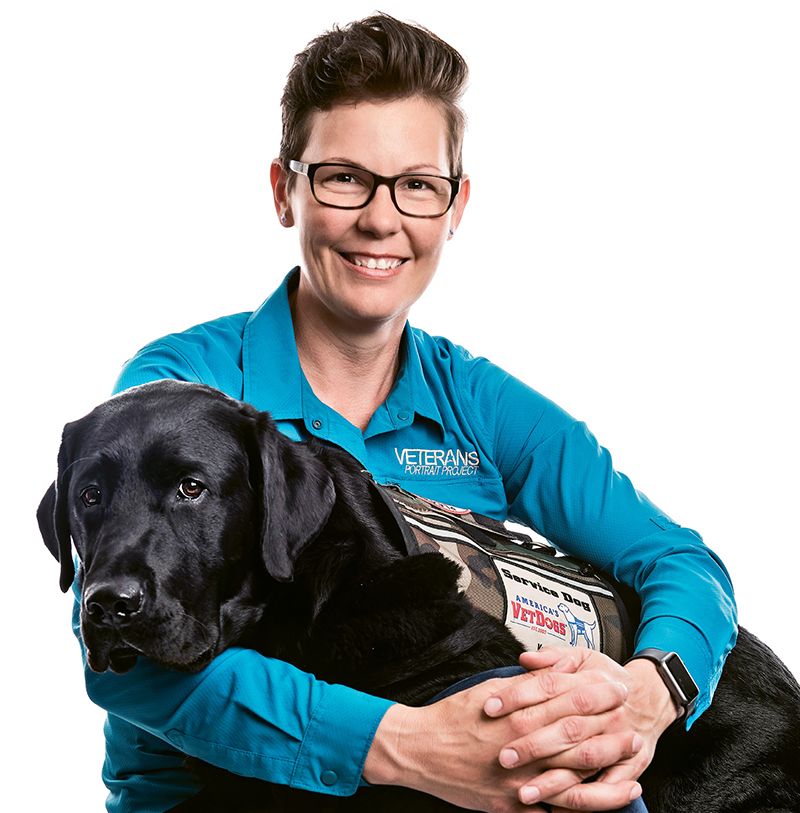Former combat photographer Stacy Pearsall honors fellow veterans through her lens and finds healing in the process

Stacy Pearsall with her service dog, Charlie, whom she received through the Today show’s ”Puppies with a Purpose” program last November.
Stacy Pearsall has found a new mission. The Air Force veteran and former member of 1st Combat Camera Squadron, a highly competitive unit of photographers, spent her 20s traveling war-torn countries and “telling the military story” through photos, until a combat injury in 2008 released her from duty; her retirement was made permanent in 2010. Pearsall’s service, however, has undoubtably continued. Following a grueling recovery process, the photographer launched the Veterans Portrait Project (VPP), a service through which she captures raw portraits of servicemen and women all over the US. Nearly a decade in, the photographer has 27 states and more than 7,500 portraits under her belt—including several that have been exhibited in the National Portrait Gallery—as well as a new ambassadorship with Nikon. “I want to make sure people’s stories don’t go untold,” she says. “I don’t have a lot to give, but I do have photography.”
Early dreams: I wanted to go to art school, but in grade school a teacher dissuaded me by saying that artists struggle to make a living, and that I shouldn’t pursue it. I went the military route at age 17 and looked for a way to engage in the arts within the service instead.
A unique perspective: What set my work apart from that of journalists, for example, was that I never left the battlefield. These were the people I slept next to and ate with; we entered experiences together that some didn’t survive. Those bonds are unbreakable. I also think being a young woman in a field of men allowed me to not only be the photographer, but a trustworthy outsider.
Capturing combat: If I put up barriers between myself and what was happening, I’d get the same invisible barrier in my photos. I had to consciously allow myself to feel the emotion of what was unfolding in front of me and to let that be reflected in my work.
After the service: When I was injured and eventually retired, all of my medical care took place at the VA. It felt like going from one conflict zone to another, frankly. I was an anomaly there—people constantly asked if I was there with my dad or my grandpa. No one ever assumed I was a veteran.
The Veterans Portrait Project is born: During that time, I thought about ending my life. I had no art, no career, my husband was deployed, and the family I loved—the military—was gone. I was sitting in the VA one day, and a gentleman sat beside me. He told me about WWII, surviving D-Day, liberating a concentration camp. It inspired me to pick up a camera and take his portrait. I’d forgotten the hospital was filled with extraordinary stories.

Pearsall’s portraits of veterans (clockwise from top left) Cami Gage, Martin K. Newton, Paul A. Koshewa, and Philip George. To support the VPP, visit veteransportraitproject.com.
Relatability factor: Once, I was in deep conversation with one of the veterans, and his wife started weeping. Afterwards, she told me it was the first time she’d ever heard him talk about his experience in Vietnam. The Project offers a platform for veterans to share without fear of judgement, and it’s astounding how many will open up in just a few minutes.
Creative vision: I don’t shoot in color because I want to eliminate distractions and for the portraits to be timeless. I want people to look at the emotion on the subject’s face. I try not to capture what they’re projecting, but who they really are.
On the exhibits: The person standing next to you at the grocery store could be a war hero, and you might never know it. What’s extraordinary about having my work exhibited in museums and local VAs is allowing the veterans I’ve photographed to come and meet their community and to really be seen.
Road work: Traveling for the VPP, I average about 25 to 30 cities a year. Delta actually stepped in and donated the airline miles for me to complete the remaining 23 states.
Canine companion: Charlie offers counterbalance and support—if I’m photographing from the floor, he stabilizes me so I can stand up, and he retrieves gear I need. When I have anxiety, he offers emotional support. But Charlie doesn’t just help me. When we’re around other veterans in need, he identifies that and gives them snuggles.
Words of wisdom: One regret I have is listening to what I was told about art when I was younger. You are in a world of what you make for yourself: keep your head high and don’t let potential hurdles become stumbling blocks. Instead, take a leap of faith—you may find that you soar through it.
-----
Heroic Tale: Read our October 2012 feature on Pearsall, ”Out of the Shadows.”
Photographs (5) courtesy of Stacy Pearsall